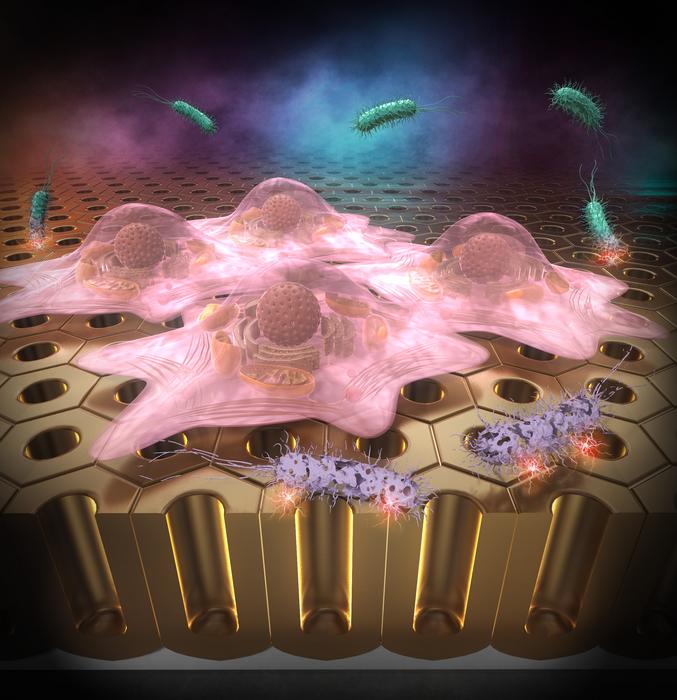
Tokyo Metropolitan University has recently made a significant advancement in the realm of biomaterials through the development of anodic porous alumina (APA) surfaces, a product of cutting-edge electrochemical techniques. These nanostructured surfaces exhibit extraordinary antibacterial properties while remaining conducive to cell culture, a breakthrough that holds tremendous promise for applications in regenerative medicine. The research, spearheaded by a team under the guidance of Professor Takashi Yanagishita, opens new avenues for creating sterile environments that are safe for the cultivation of living cells.
The core structure of these surfaces stems from anodization, a process where aluminum is immersed in a sulfuric acid solution and subjected to an electric current. This results in an organized array of nanopillars of alumina that not only enhances the mechanical strength of the material but also optimizes its surface characteristics for biological interactions. The scale of these nanopillars is crucial; they are engineered to be just small enough to disrupt bacterial cell walls, thus preventing harmful bacterial growth while allowing for the safe proliferation of mammalian cells.
Traditional methods for preventing bacterial contamination in laboratory settings often rely heavily on antibiotics. However, the overuse of these antibiotics has led to an alarming rise in antibiotic-resistant strains of bacteria, posing serious risks to patient health and complicating treatment regimens. The APA surfaces promise to sidestep these issues, offering an innovative alternative that supports cell culture without the drawback of chemical additives that could lead to resistance development.
In addition to their antibacterial properties, the unique nanostructured surface of APA can facilitate better cell attachment and growth. Studies have indicated that cells cultured on these surfaces exhibit normal morphology and viability, suggesting that they can be used for extensive research and therapeutic applications. This discovery is particularly impactful for the field of regenerative medicine, where high-quality cell cultures are essential for producing tissues and organs for transplantation.
Another significant advantage of these APA surfaces is their ease of manufacture. By optimizing the anodization conditions, the researchers have developed a cost-effective process that can be scaled up without compromising the quality or functionality of the surfaces. This sets the stage for widespread adoption in laboratories and hospitals, enhancing the availability of biologically compatible materials for a variety of applications.
The implications of this research extend beyond just laboratory settings; the ability to culture cells without bacterial contamination has far-reaching impacts on clinical outcomes. In regenerative medicine, where engineered tissues are transplanted into patients, any bacterial contamination could lead to severe immunological responses or graft failures. By employing these advanced surfaces, clinicians can potentially improve patient safety and the efficacy of treatments, paving the way for novel therapeutic strategies.
Furthermore, the research aligns well with broader initiatives to reduce the reliance on antibiotics in medicine. In a time when the world is grappling with the consequences of antibiotic misuse, the ability to create a sterile environment without chemical interventions could significantly contribute to public health efforts to combat antibiotic resistance. This innovative approach may set a precedent for the development of other biomaterials that prioritize safety and efficacy without compromising ethical standards in science.
As the research continues to develop, further studies will likely explore the full range of applications for APA surfaces beyond cell culture. Potential uses may include artificial scaffolds for tissue engineering, implants that reduce infection rates, and a variety of other applications across materials science and healthcare sectors. Each of these avenues represents a step forward in the quest for safer, more effective medical solutions.
The team’s findings are expected to stimulate further research within the academic community, encouraging collaborations aimed at translating this technology from the laboratory to clinical practice. With the ongoing exploration of materials that can seamlessly integrate with biological systems, researchers are hopeful that APA surfaces will inspire innovations that could change the landscape of medical treatments and biomaterials.
In conclusion, the research conducted by Tokyo Metropolitan University illuminates an exciting frontier in materials science and regenerative medicine. The development of antibacterial yet biocompatible anodic porous alumina surfaces not only represents a significant technological advancement but also offers a safer alternative to conventional antibiotics in cell culture and regenerative applications. As the scientific community continues to explore these new materials, the future of medicine could look remarkably different, driven by innovations that prioritize patient health and ecosystem sustainability.
Subject of Research: Anodic porous alumina surfaces for cell culture and bacterial resistance
Article Title: Evaluation of the Antibacterial and Cell Culture Properties of Anodic Porous Alumina Prepared in Concentrated H2SO4
News Publication Date: 6-Dec-2024
Web References: http://dx.doi.org/10.1021/acs.langmuir.4c03873
References: Not provided
Image Credits: Credit: Tokyo Metropolitan University
Keywords
Antibacterial, Cell Culture, Nanostructures, Regenerative Medicine, Bacterial Resistance, Biomedical Engineering, Material Science, Electrochemistry, Tissue Engineering, Biocompatibility.





